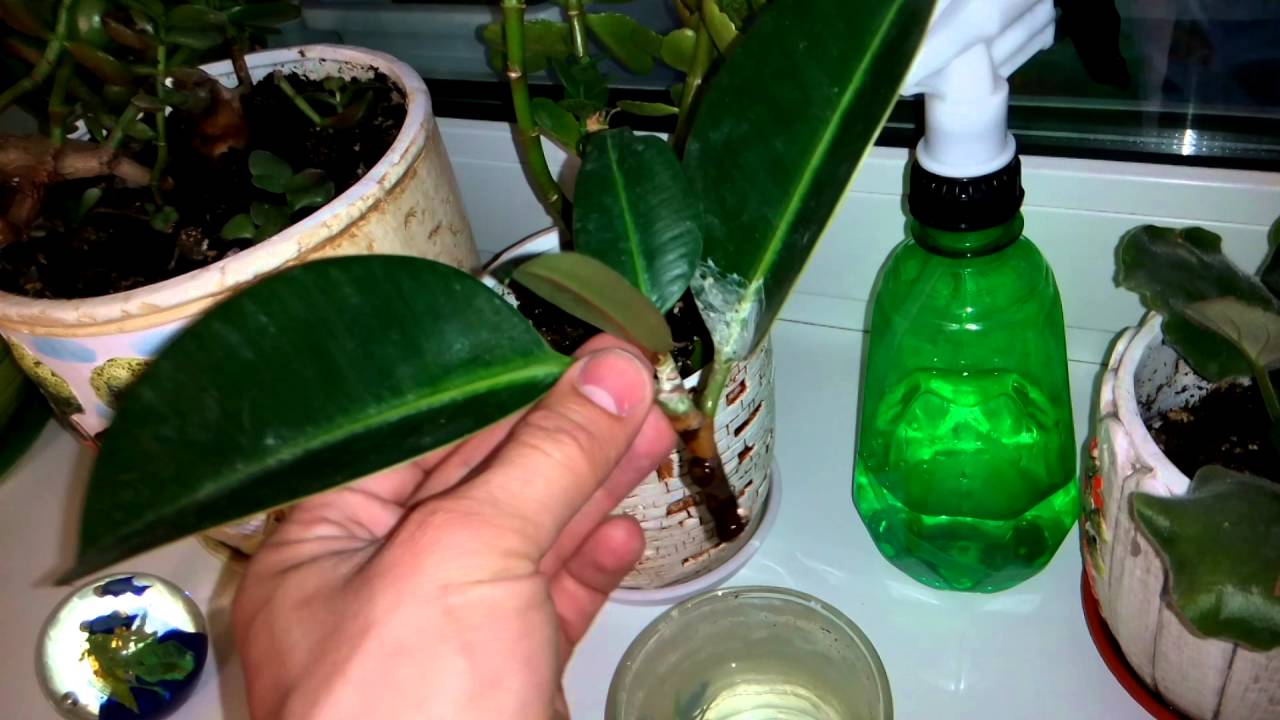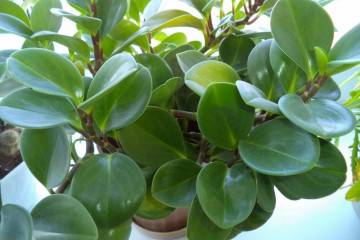Ficus lyre - home care
Content:
Ficuses are popular indoor flowers. This plant has a large number of varieties that differ in spring appearance and size. Ficus lyre deserves special attention. It is perfect for landscaping offices and living rooms.
Description of the plant
Ficus lyre (lat.Ficus Lirata) is an evergreen plant belonging to the Mulberry family. The name comes from the lyre-shaped sheet plates. In natural conditions, it grows in the tropics of Africa and can grow up to 30 m in height. In a home environment, it rarely exceeds 3 m.
The trunk of the ficus is erect with a slight roughness. The bark is light brown. Leaves are hard and thin. A drawing is clearly visible on their surface. In length they can grow up to 50 cm with a width of no more than 25 cm. The surface of the leaves is glossy and slightly wrinkled. Painted in deep green.
The most popular in floriculture are three varieties of lyre ficus:
- Kulumnaris is a large columnar ficus that grows only upward;
- Bambino is a compact branched variety with small leaf blades;
- ficus Lirata is a medium-sized plant (1-1.5 m) with large leaf blades.
Care features
Lyre ficus involves special care at home, which you should be aware of when growing it. Mistakes in this matter can lead to leaf fall and other problems.
Temperature
Since ficus is a tropical plant, the optimum temperature for growing it should be as follows:
- in summer within 20-25 ° С;
- in winter within 16-20 ° С.
Ficus does not tolerate sudden changes in temperature, which can lead to stains on the leaves. The soil in the pot should also not be too cold.
Lighting
A tropical plant loves good lighting, so the room should be on the sunny side. In this case, the place should be chosen so that the sun's rays do not fall on it.
In the room on the north side, the ficus will experience a lack of sunlight, and on the south side, it will receive burns from direct sunlight. The best location would be east and west. In winter, UV lamps can be used to extend daylight hours.
Watering
Improperly organized watering can lead to the death of the plant. The frequency of soil moistening depends on several factors:
- soil type;
- air humidity;
- temperature conditions.
Before watering the ficus, the earth should dry well. In summer, the frequency of the procedure is 2-3 times a week, and in winter, watering is done no more than 1 time a week.In this case, it is recommended to use water at room temperature.
Spraying
To maintain sufficient moisture, you should regularly spray the flower with a spray bottle. The procedure is carried out all year round using warm, settled water.
Humidity
For ficus Lyrata, care also consists in creating high humidity. This can be achieved in several ways:
- using a humidifier;
- wiping the leaves with a damp cloth;
- spraying from a spray bottle;
- warm shower.
Priming
It is preferable to plant in fertile soil with neutral acidity. Ready-made land can be purchased at a flower shop or you can independently mix leaf and sod land in equal parts, as well as 0.5 parts of river sand with charcoal.
Top dressing
For the proper development of the plant, it will be necessary to apply fertilizers that feed the soil with all the necessary trace elements. Of the complex formulations are suitable: "Bona Forte", vermicompost and "Raduga". You can also use for feeding:
- superphosphate. It will provide the root system with the required amount of phosphorus;
- wood ash. The ash is poured with hot water, after which it is infused for a week. Such fertilization is the prevention of insect pests, and also saturates the soil with potassium.
Features of winter care
In winter, in a room where lyre ficus grows, the temperature should not drop to 12 ° C. A flower can survive such a decline only for a short time and under the condition of minimal watering.
Ficus flowering
Ficus flowering is possible only in nature or in the conditions of a botanical garden. When grown at home, the appearance of syconia - round inflorescences is possible. Outwardly, they look more like green fruits, which over time can acquire yellow and orange hues.
Inside, these inflorescences are hollow, only seeds are located in them. Outside, on the surface there is a small hole through which insects penetrate and pollinate the flower under natural conditions. At home, pollination does not occur, so the seeds are not suitable for reproduction, and the inflorescences themselves take a large amount of energy from the ficus. That is why it is recommended to delete them in a timely manner.
Pruning
You can prune the plant in order to form a crown. The process should be performed in the spring, when its active growth is observed. This procedure has a beneficial effect on the plant, allowing the development of lateral shoots.
Reproduction
This type of ficus can be propagated in several ways:
Seed propagation
Since it is not possible to get mature seeds in home growing conditions, purchased planting material is used for propagation. Selected seeds are soaked in warm water. Growth stimulants can be added to accelerate the emergence of sprouts.
After 4-5 days, the seeds are planted in warm and moist soil, after which they are covered with polyethylene to create optimal conditions. The film is removed after 1.5-2 weeks, when sprouts appear.
Rooting cuttings
Before cutting off the cuttings, it is recommended to water the plant well and allow time to be saturated with moisture. Cuttings should be prepared the day after watering.
For planting material, a strong and healthy stalk is selected, which is carefully cut at an angle. The top 2-3 leaves are left on it, and the rest are removed.
Air layering
To propagate the ficus by layering, a place on the trunk is selected where the rooting of the shoots is planned. It is desirable that at least 60-70 cm from the top be at least 60-70 cm. Sheet plates are removed on site and two small cuts are made at a distance of 3 cm from each other.
The bark between the incisions is carefully removed.The site itself is treated with any drug that stimulates root growth. Then wet moss is applied in place. After 2-3 weeks, a shoot grows, ready for transplantation to a permanent place.
Possible growing problems
When growing ficus, the following problems may arise:
- yellowing and falling of leaves. A common cause is too dry air. Leaves should be wiped with a damp cloth or sprayed;
- leaves do not grow and fall off. This problem is inherent in a lack of nutrients. Fertilization will help to correct the situation;
- the leaves curl up and turn brown. The disease is characterized by an excess of sunlight or high soil moisture;
- falling of the lower leaves. Occurs due to insufficient watering;
- partial leaf fall. This situation can arise with a sharp change in the situation.
Ficus pests
Ficus pests can be:
- spider mite. You can get rid of it with drugs Mavrik, Vertimek, etc.;
- mealybug. It is recommended to wipe damaged leaves with an alcohol solution, and then rinse with soapy water;
- shield. If adult insects can be removed on their own, then fungicides will be needed in the fight against larvae;
- orange aphid. A solution of liquid soap and tobacco is considered an effective remedy in the fight against it.
Folk omens
Growing ficus in the house has acquired signs and superstitions. So, the Slavs believed that:
- ficus awakens anger, envy and other sins in a person;
- with the appearance of this plant in the house, love in the family disappears;
- ficus is a symbol of a lonely person.
Europeans have a completely opposite opinion about this plant. For them:
- ficus is able to improve the family environment and strengthen feelings;
- the plant gives comfort to the house and helps to solve problems;
- is the keeper of the hearth.
Which signs to believe and which not, everyone decides independently. But one thing has been scientifically proven - lyre ficus is a powerful natural air purifier. And if you take care of it correctly, then the flower will become a spectacular decoration for any home.





















